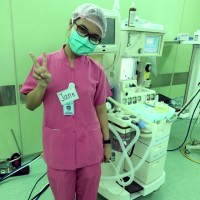Blepharoplasty local anesthesia
Local anesthesia usually adequate
Eyelid surgery, like any kind of surgery, usually requires some kind of anesthesia. I would not recommend surgery be done without anesthesia nowadays.
Local anesthesia is relatively painless to administer, and within a few minutes the area will be numb for a couple of hours. Usually, eyelid surgery can be done quite adequately under just local anesthesia depending on the patient.
Patients who are unusually sensitive may require additional anesthesia such as IV sedation in addition to the local. Rarely is general anesthesia required for eyelid surgery. (James Tang, MD, Houston Plastic Surgeon)
Intravenous sedation (twilight sleep) combined with local anesthesia is best for eyelid surgery
I perform eyelid surgeries on the majority of my patients without using general anesthesia. Instead, I prefer to use intravenous sedation, otherwise known as twilight sleep, combined with local anesthesia.
The twilight sleep relaxes you and eliminates any discomfort while the local anesthesia is being placed. The local anesthesia completely eliminates any pain sensation, while at the same time minimizing any bleeding during the surgery. (Michael R. Macdonald, MD, Bay Area Facial Plastic Surgeon)
Eyelid surgery can be safely performed under local anesthesia.
Eyelid surgery, or blepharoplasty, can safely be performed under local anesthesia. In my experience, upper eyelids can easily be performed under straight local (numbing injections) or can be performed with local with some sedation. Lower eyelid surgery is often more complex than upper eyelid surgery and most patients prefer to have general anesthesia (go completely to sleep) for this procedure. Having local anesthesia instead of general anesthesia can also offer a significant cost savings. (Gregory Pippin, MD, Metairie Facial Plastic Surgeon)
Blepharoplasty and types of anesthesia
In my practice in Newport Beach, California I offer several options for anesthesia. These are usually discussed in the preoperative and consultative phase and depend on the extent of the surgery and if the blepharoplasty is being done as a single operation and not in conjunction with other procedures. Blepharoplasty is a term used for both upper and lower eyelid surgery.
In respect to the upper eyelid area lidocaine or a local anesthesia may be used and usually accompanied with some IV sedation just to make the patient comfortable for the local injections. With lower eyelid surgery if there is a lot of fat to be removed which can be uncomfortable to the patient I would strongly suggest IV sedation with the local sedation. I personally do not perform many procedures without my anesthesiologist present. Patient comfort and safety are a top priority. With a skilled anesthesiologist you should be pain free, have a quick recovery and completely safe. (Michael Elam, MD, Orange County Facial Plastic Surgeon)
Can Eyelid Surgery Be Done Without Anesthesia?
Eyelid surgery can and very often is done with only local anesthesia. This means that the patient gets injections to the areas being operated on and is wide awake for the whole procedure. This type of anesthesia is well tolerated by most people. Some people prefer to be completely asleep and some prefer “twilight” anesthesia. (Sam Goldberger, MD, Beverly Hills Oculoplastic Surgeon)
Can Eyelid Surgery Be Done Without Anesthesia?
I don’t know of many patients that can tolerate surgery without some kind of anesthetic, so I am assuming your concern is regarding the difference between general anesthesia and local (general anesthesia is when you are “put under”, versus lidocaine or some other local anesthetic that is simply injected into the surgery site to numb the local area).
It is definitely possible to do a blepharoplasty with either local or general; it is really up to you to decide what you would rather do. Something to think about when deciding what kind of anesthesia you want: risks, pain tolerance, and cost are a few good ones.
Make sure you find a well-qualified plastic surgeon that has done several blephs (especially in-office ones that use only local anesthesia) before having the procedure done. Good luck!



